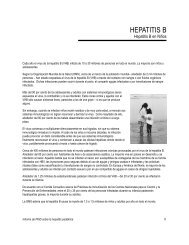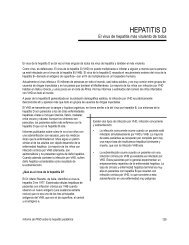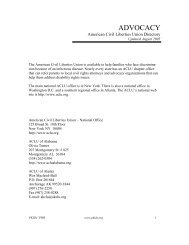Milk Thistle: Effects on Liver Disease and Cirrhosis - Parents of Kids ...
Milk Thistle: Effects on Liver Disease and Cirrhosis - Parents of Kids ...
Milk Thistle: Effects on Liver Disease and Cirrhosis - Parents of Kids ...
Create successful ePaper yourself
Turn your PDF publications into a flip-book with our unique Google optimized e-Paper software.
outcome assessment or interventi<strong>on</strong> administrati<strong>on</strong>, <strong>and</strong> study designs. Relati<strong>on</strong>ships between<br />
clinical outcomes, participant characteristics, <strong>and</strong> methodologic characteristics are presented in<br />
evidence tables <strong>and</strong> graphic summaries such as forest plots.<br />
Primary outcomes in studies were measured with c<strong>on</strong>tinuous rather than categorical<br />
variables. We used the st<strong>and</strong>ardized mean differences between treatment <strong>and</strong> comparis<strong>on</strong> group<br />
scores as the effect size measure for each study. Hedges’ g was used to compute the<br />
st<strong>and</strong>ardized mean difference for each trial:<br />
g<br />
i<br />
x − x<br />
=<br />
s<br />
T C<br />
where, for a given trial i, x T <strong>and</strong> x C are the mean clinical outcome scores for the treatment<br />
group <strong>and</strong> comparis<strong>on</strong> group, respectively; spooled is the pooled st<strong>and</strong>ard deviati<strong>on</strong> for the<br />
difference between the two means. 57 These estimates were adjusted for between-group<br />
differences at baseline <strong>and</strong> for small sample bias. 57 Adjustment for baseline differences was<br />
accomplished by calculating an “effect size” at baseline; by definiti<strong>on</strong>, it should be zero if study<br />
groups were well matched. When a n<strong>on</strong>zero “effect size” at baseline was found, outcome effect<br />
sizes were adjusted by subtracting the baseline effect size.<br />
Published reports seldom provided estimates <strong>of</strong> spooled. One <strong>of</strong> three strategies was used to<br />
estimate spooled when the authors did not directly provide it. First, the individual group variances<br />
were used to estimate spooled. If these data were not reported, the pooled variance was backcalculated<br />
from either the test statistic or the p value for differences at followup. 58 If neither was<br />
possible, a mean variance derived from studies <strong>of</strong> similar size was used. Studies in which the<br />
pooled variance was calculated using either <strong>of</strong> the two latter methods were flagged in the event<br />
the magnitude <strong>of</strong> the effect size resulted in the study being identified as a potential outlier in the<br />
analysis <strong>of</strong> heterogeneity.<br />
Exploratory Meta-Analysis<br />
Meta-analysis was used as an exploratory tool to help identify patterns <strong>of</strong> findings.<br />
Prospective placebo-c<strong>on</strong>trolled r<strong>and</strong>omized trials using albumin, bilirubin, aspartate<br />
aminotransferase (AST), alanine aminotransferase (ALT), gammaglutamyl transpeptidase<br />
(GGTP), mal<strong>on</strong>dialdehyde (MDA), alkaline phosphatase (alk phos), prothrombin time (PT),<br />
Child’s score (a score or classificati<strong>on</strong> system for chr<strong>on</strong>ic liver disease), <strong>and</strong> histologic <strong>and</strong><br />
survival outcomes were quantitatively pooled by clinical outcome using meta-analysis.<br />
Subgroup analyses were c<strong>on</strong>ducted for trials that included patients with the following: chr<strong>on</strong>ic<br />
alcoholic liver disease, acute viral liver disease, chr<strong>on</strong>ic viral liver disease, mixed liver disease<br />
(all chr<strong>on</strong>ic), cirrhosis, <strong>and</strong> alcoholic cirrhosis.<br />
We adopted the DerSim<strong>on</strong>ian <strong>and</strong> Laird r<strong>and</strong>om-effects model to estimate the pooled<br />
measures <strong>of</strong> treatment efficacy. 59,60 If there is no substantial heterogeneity am<strong>on</strong>g the trials, the<br />
r<strong>and</strong>om-effects estimator reduces to the classical fixed-effects estimate. When significant<br />
heterogeneity exists, the r<strong>and</strong>om-effects model incorporates the statistical heterogeneity into the<br />
summary estimate <strong>and</strong> c<strong>on</strong>fidence interval. The r<strong>and</strong>om-effects model c<strong>on</strong>fidence interval is<br />
wider than the fixed-effect model c<strong>on</strong>fidence interval, when substantial heterogeneity exists,<br />
making the r<strong>and</strong>om-effects model more c<strong>on</strong>servative.<br />
23<br />
pooled






